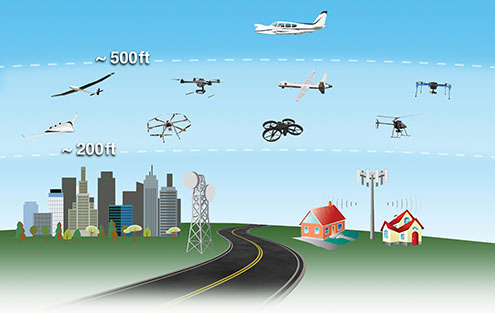By Arthur Holland Michel
The Drone Revolutions was an advanced undergraduate seminar organized by the Center for the Study of the Drone, taught in the Human Rights Program at Bard College during the Spring 2016 semester. The class was led by Thomas Keenan, Dan Gettinger, and Arthur Holland Michel. The Drone Revolutions aimed to give students a broad overview of the many dimensions of drone history, development, and use in both military and civilian spheres, as well as to introduce them to research strategies for issues at the intersection of technology and policy.
We built the class around a central question: Are drones a revolutionary technology? By framing the subject in this way, our intention was to enable students to consider both the challenges and opportunities presented by drone technology in a careful, research-driven way. In our abstract for the class, we describe how we hoped students would approach the topic:
Peering into a future in which autonomous weapons systems target and kill without human intervention, and drone highways criss-cross the American skies, this seminar should equip students with the knowledge and analytic skills to judge whether we are indeed on the edge of one or more “drone revolutions.”
In order to give students an opportunity to analyze the subject closely and fairly, we placed an emphasis on direct engagement with primary sources. Readings for the class sessions included government reports, regulatory documents, archival materials, and promotional videos, among other things. Students were expected to read these documents closely and critically. These documents were supplemented by secondary sources including scholarly papers, essays, think tank reports, and news stories.
Our core text for the class was Peter W. Singer’s Wired for War: The Robotics Revolution and Conflict in the 21st Century. This book, which was published in 2009, declared that a revolution in military robotics and unmanned systems was upon us, and described the profound effects that this transformation would likely have in the military sphere. The text offers a clear and accessible framework for understanding what might be meant by “the drone revolution,” and makes the case that this revolution is not only influencing the character of warfare, but likewise commerce, conservation, science, and art.
Each student in The Drone Revolutions had unique reasons for joining the class. On the first day of the semester, students shared their interests and goals for the semester. Here is a selection of what they said:
-An interest in drones and theatre.
-An interest in drones for photography.
-Looking to explore the moral and ethical dimensions of targeted killing programs.
-Hoping to know more about the history of drones.
-Interested in figuring out what is significant about the “unmanned” aspect of drones—i.e., what they can do that manned systems can’t.
-Looking to learn more about the issue of precision and collateral damage.
-Interested in the domestic political costs of the drone program in the context of U.S. anti-terror policy.
-Curious about the relationship between warfare and democracy, and the ways that drones impact that relationship.
-Interested in Yemen, and the role that drones play there.
-Curious about PTSD and other dimensions of the experience of drone pilots.
-Concerned/interested in the privacy implications of drones.
-Wanting to better unpack the public’s fear and awe of drones.
-Interested in the lag between technology and the law.
-Curious about how the media portrays drones.
We held a total of eight class sessions, which ran for two hours and twenty minutes. Each session addressed a different dimension of drone use, and included a lecture portion and a group discussion. In the final month of the semester, students worked on individual research assignments on the technologies highlighted in Wired for War, which we will build into a full report that will be published by the Center in the summer

Here is a rundown of the class sessions. A .pdf of the full syllabus is included below.
February 9: History of Drones and the Theory of a Revolution in Military Affairs
In our first full session, we sought to provide students with a broad overview of the history of unmanned flight, from the early experiments with unmanned “aerial torpedoes” during World War I through to the U.S. Air Force’s Predator drone program. We introduced students to the Revolution in Military Affairs theory as a potential approach to defining a “revolutionary” technology. Students discussed how RMA theory both describes and interacts with the development and use of military drone technology.
February 16: Targeted Killing and Terrorism
Here we covered the nature, scale, and scope the U.S. targeted killing campaign, the legal and strategic implications of drone strikes, and the and different methodologies for researching the issue. The goal of the class was to situate drone strikes within the history and practice of high-value targeting and terrorism.
February 23: Why Does Everybody Want a Drone?
This session examined the domestic use of drones for recreational and non-recreational purposes, as well as the Federal Aviation Administration’s efforts to integrate drones into the national airspace. Students discussed the factors motivating the growth of the domestic drone industry—i.e., the reasons why “everybody wants a drone”—and considered the industries and sectors that are most likely to adopt and benefit from the technology. We covered the history of drone regulations, focusing on the ways in which advances in technology have driven the new regulations. Finally, we analyzed the broader challenges that the FAA faces in regulating drone use while also enabling the industry to grow.

March 1: Arts, Culture, and Surveillance
This class addressed the wide variety of artistic depictions of—and responses to—the drone in all its forms. The goal was to analyze the themes, vocabularies, and points of tension within the genre that we describe as “drone art.” Students unpacked the work of artists like Trevor Paglen, Mahwish Chishty, and KATSU, each of whom offer a different interpretation of what “the drone” means and why it matters. Students considered the possible reasons for why drones fascinate and frighten society, and why the technology has provoked such a colorful and expansive response from the art world.
March 8: Our Drone-filled Future
Here students considered the near future of civilian drone technology. The session was built around a guest lecture by Nader Elm, CEO of Exyn Technologies, a startup that is commercializing the work of Dr. Vijay Kumar and the University of Pennsylvania GRASP Lab. In his talk, Nader shared his predictions for the near future of drone technology, taking students on a whirlwind tour of swarming drones, search and rescue drones, and advanced sensor technologies that enable a high degree of autonomy. Nader also described some of the challenges that the domestic drone industry is likely to face in the next five years, including public pushback, the search for a “killer app” for unmanned systems, and regulatory obstacles.
March 15: Global Drone Proliferation
This class offered examined the extent to which drones are used by countries outside of the United States. The lecture portion of this session introduced students to the wide array of unmanned systems currently either deployed or under development in countries such as China, Iran, Pakistan, and Syria, and examined some of the strategic and tactical motivations for drone use and development. The goal of the class was to understand how drones may be used by in a variety of global contexts and how the proliferation of this technology may alter the strategic calculus of the countries involved.
March 29: Drones in the Near Future and Autonomy
Here we considered the likely trajectory of drone technology and systems development in the near future. In particular, the class focused on understanding the different levels of autonomy in military unmanned systems, and the degree to which human operators are “in the loop” or “on the loop” when operating various current and future systems. The goal of the class was to have students consider whether the introduction of highly autonomous weapons would result in a permanent shift in how wars are fought, and whether the deployment of these systems would pose any significant ethical, tactical, or policy-level challenges.
Reflections
From the outset it was no secret that the class would not lead students to a single, concrete answer to the question of whether drones are a revolutionary technology. But this leading question did prove to be a useful beacon in guiding students through complex material and topics, such as the FAA’s regulatory process, or the tactical implications of surveillance drones in the East China Sea. The class discussions reflected the complexity that underlies that seemingly simple question.
In the final class of the semester, the students gathered to share their research projects and discuss their takeaways from the class. Students held a variety of different perspectives on whether indeed drones are a revolutionary technology. Some argued that by enabling a remote intelligence collection and strike capability, military unmanned aircraft do represent a Revolution in Military Affairs. Others contended that on a broader level, the difference between a drone strike or a manned form of kinetic engagement is not significant; what matters, they argued, was the underlying policy and strategy—the drone is simply a tool. Some felt that the true measure of whether a military technology is revolutionary was not its tactical or strategic implications, but rather its impact on civilians in a war zone. In the civilian arena, some students suggested that the ability to put a camera in the sky cheaply and easily was a game-changing proposition, but that the complexity of integrating such systems into existing policy frameworks hampered their potential to a degree. Students appeared somewhat disinclined to contend that hype heavily outweighs reality, though they did suggest that unmanned technology at its current level yielded more significant changes to military affairs than it does in the commercial sector.
The class was ambitious in its scope, and we recognized from the outset that we wouldn’t have time to cover every significant facet of the world of drones. Some students pointed out that they would have liked to spend more time considering the psychological and emotional effects of operating military drones. By extension, other students would have liked to learn more about how the evolving experience of the warfighter affects our broader conceptions of and assumptions about warfare. Those students who came to the class looking to learn more about drones as they relate to certain specific fields—for example, drones and theatre—had to venture beyond our syllabus for answers, though our hope is that the class provided some of the fundamentals that will prove helpful for those students who are looking to extend their research outside the classroom.
Syllabus:
[gview file=”http://dronecenter.bard.edu/files/2016/05/HR319-The-Drone-Revolutions-Syllabus-Spring-16.pdf”]
For updates, news, and commentary, follow us on Twitter.
[includeme file=”tools/sympa/drones_sub.php”]
